Water, water, everywhere…
Camping in the backwoods or traveling through Mexico means you’ll need clean drinking water all day, every day. Even if you’re surrounded by enough civilization that bottled water is readily and cheaply available, it doesn’t hurt to have a portable water filter or purifier for those days when all the stores are closed, or you’re too lazy to go outside, or you see someone filling up empty water bottles from the tap to be resold in stores again. Ew.
Luckily for all of us, portable water filters have actually gotten pretty great recently. And no, I’m not talking about the well-known options that have great marketing and cost hundreds of dollars and don’t filter out viruses dammit. Why do they cost so much if they still let bugs through that’ll kill me!? Argh!
The options I’m talking about are comprehensive filtration devices, with technology so good that they’ll handle even the tiniest of microscopic organisms, which most traditional backpacking filters can’t handle. You can fill up from a stagnant pond in sub-Saharan Africa and you’ll be just fine. And isn’t that lovely?
What kind of water filter or purifier do I need?

This is where it starts getting technical, but the way I look at it, there are three major categories of contaminants worth discussing:
- Chemical: Lead, arsenic, chlorine, and iodine come to mind. These are more often found in tap water than river water, so if you’re traveling abroad (or filtering at home), you’d want something that can help with these. Dirt and dust are important to remove as well, but pretty much every filter on the market will do that. I’m not aware of anything that’ll filter out all chemicals, but carbon filtration is the most common method for handling these, and is quite helpful.
- Bacterial (and bacterially-sized things): These are the most common biological contaminants, and the most important things to filter, whether you’re traveling to another country, or hiking in your own. There are other microorganisms out there that can cause illnesses (such as protozoan cysts, like giardia and cryptosporidium), but they’re similarly sized, so if a filter can handle bacteria, they can handle the other ones too.
- Viral: Viruses, the smallest organisms on earth, bypass most filters. Viruses are pretty rare, and generally only found in rural environments in developing countries. You probably don’t need viral filtration if you’re hiking through North America or Western Europe (which is part of the reason why filters that remove viruses are so rare), but…well, if it can do it, great.
Ideally, you’d want something that can handle all three, and that’s what this list is about. To the best of my knowledge, these are the best portable water purifiers on the market today. Significantly cheaper options exist, they won’t work nearly as well as these.
This list is split into two parts, starting with…
Part 1: If you need total filtration (including viruses)
The following devices offer all-in-one filtration, including large dirt particles, harmful chemicals, bacteria and bacterially-sized microorganisms (like cysts and giardia), and viruses. If you’re going to remote areas in developing countries, viral filtration is important; if you’re hiking around North America or filtering tap water in Western Europe, you probably don’t.
There are certain things they won’t remove (salt, for example), but the options listed here offer the most comprehensive filtration on the market, and you probably won’t find something that does. These will remove all harmful biological contaminants, and certain chemicals, making tap water or river water taste great, and safe to drink.
1) Lifesaver Bottle: $150
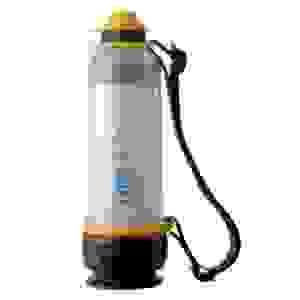
Update: It looks like the Lifesaver will be discontinued. I’m not entirely sure if this is temporary, but I’ll keep this updated if things change.
The Lifesaver Bottle was designed for the developing world, featuring an all-in-one portable water purifier that could provide clean drinking water for the 3 billion people that need it at a total investment of $20 billion. Makes you want to donate, doesn’t it?
As its design goals were simplicity and cost-effectiveness, it happens to suit the needs of backpackers and hikers just as well, and is readily available for purchase by first-world consumers, who are encouraged to participate in a buy-one, donate-one program.
The bottle has a filtration and pump system housed entirely within the bottle, so you pump a few times to press the water through the super-fine filter, and then you can drink. The bottle has a watertight cap, a carrying strap, has completely replaceable parts, and can even handle viruses.
For a while the Lifesaver was far and away the most cost-effective option on the market, though a couple new options have emerged that are lighter, don’t require pumping, and don’t need to be submerged upside down in a river to fill it up, like the Lifesaver does; but it’s still quite good.
The following numbers are estimates for the $150 Lifesaver Bottle 4000, with a limit of 4000 liters, and assume high-frequency replacement of carbon filters, available in $30 packs of 4 which treat 250 liters each. The 6000 liter version and carbon filter value packs can reduce the long-term costs listed below by about half.
- Unit price: $150 (4000 liter version)
- Replacement parts: $100 per cartridge, $8 per carbon filter, $6 per pre-filter
- Lifespan: 4000 liters (carbon filters need more frequent replacement)
- Initial water treatment cost: $0.06 per liter
- Recurring water treatment cost (replacement cartridges + filters): $0.05 per liter
- Empty weight: 22 ounces (623 grams)
Buy it here.
2) The Grayl Ultralight: $60
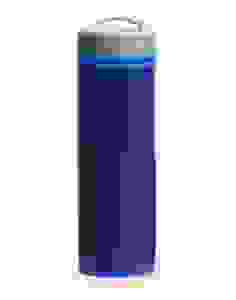
Frequently referred to as the Holy Grail of water purifiers (doesn’t everyone love puns?) the Grayl was designed by someone who got tired of drinking from sporty bottles with gigantic logos and flashy colors. This one offers the same great filtration performance as anything else you’ll find, but without the need for pumping, sucking, squeezing, or waiting.
The filter mechanism works like a French press; you fill up the lower chamber, and press the upper unit down into it. It takes about 15 seconds, after which you can drink just like you would from a regular bottle, without having to suck up the water through a straw. It also means you can pour out purified water into a cup for a friend, or fill up spare bottles for a long trip, and you’ll be hauling clean water around with you, instead of dirty water.
The Grayl has multiple filter unit options which can be swapped out according to your needs, including a low-cost tap water filter, or the top-of-the-line Purifier cartridge, which can handle viruses (removing 99.9999% of them), and 99.9999% of bacteria, along with other microorganisms and chemicals, with a 150 liter lifespan. From what I have seen, its filtration quality is the best of anything on this list.
The numbers below are for the Purifier cartridge, which is what you’d want for outdoor backpacking or international travel.
Full disclosure: They’ve provided me with some free test samples, and, years after the reviews, made me a revenue-sharing offer as well. But I like it a lot. Check out a very in-depth review here.
- Unit price: $60
- Replacement parts: $25 per cartridge (Purifier)
- Lifespan: 150 liters
- Initial water treatment cost: $0.40/liter
- Recurring water treatment cost (top-of-the-line Purifier unit): $0.16/liter
- Empty weight: 10.9 ounces (309 grams)
Buy it from TheGrayl.com.
3) Aquamira Frontier Bottle (Red Line): $50
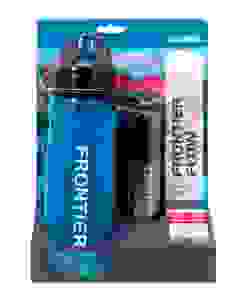
This is a recent upgrade to a previous Aquamira bottle; the new ones adds viral protection (in addition to chemical and bacterial and other microorganisms), making it seriously effective anywhere in the world.
Because it’s a recent modification to the Aquamira lineup, you’ll need to make sure it specifies viral protection (if that’s what you need, of course), and the replacement filters will be labelled Red Line. The bottle has other replacement filters, such as Green Line, but that’s for non-viral filtration (good for hiking in North America, and significantly cheaper, so it’s useful that you can swap them out as needed).
The numbers listed here are for the Red Line filter, to provide a direct cost comparison with the other top-of-the-line filters listed here, and the numbers are pretty great. It removes chemicals, 99.9999% of bacteria, and 99.999% of viruses and other microorganisms, with a 450 liter lifespan. The squishy straw is the type of thing that might need to be cleaned out every once in a while, but that’s true of most bottles anyway.
Full disclosure: The manufacturer has provided me with a few test products (though not this particular item), but all these numbers are accurate.
- Unit price: $50
- Replacement parts: $40 per cartridge (Red Line filter)
- Lifespan: 450 liters
- Initial water treatment cost: $0.11 per liter
- Recurring water treatment cost (cartridges): $0.08 per liter
- Empty weight: 5.6 ounces (158 grams)
Get it here.
They also make an in-line filter for attaching to a hydration bladder hose, which offers the same virus-removing performance, and is (at the moment) the only one I know of that does that.
4) Water to Go Bottle: $40 (approximately)
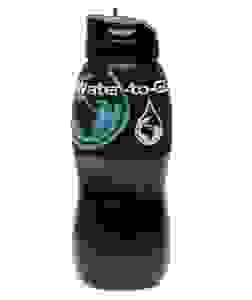
This is another one that might require overseas shipping, depending on where you live, but even with British pound conversion and international shipping costs, it’s still rather affordable.
The Water to Go Bottle removes 99.9% of biological contaminants (including viruses) and certain harmful chemicals, using a NASA-developed technology that removes particles from the water without using a “real” filter, but through a process called adsorption, though it also includes a carbon component for soaking up chemicals.
(The site claims it removes 99.9% of all microbiological contaminants, but elsewhere on the site they’ve listed the test results, which put both virus and bacterial removal at 99.9999%, and other types at 99.99%. I’m not sure what the 99.9% refers to.)
There’s a smaller bottle available as well, but the numbers here are for the one in the photo. Prices on their site are listed in British pounds, and the numbers here assume a conversion rate of 1 British pound equal to 1.5 American dollars, and don’t take into consideration the international shipping costs:
- Unit price: $37.50
- Replacement parts: $13.5 per cartridge
- Lifespan: 200 liters
- Initial water treatment cost: $0.18 per liter
- Recurring water treatment cost (cartridges): $0.067 per liter
- Empty weight: 4.8 ounces (138 grams)
Get it here.
5) Katadyn MyBottle: $60
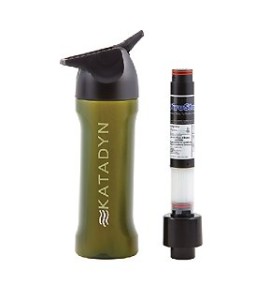
The Katadyn MyBottle uses a combination of filtration and iodine purification, to remove particles, and kill whatever microorganisms are inside. This is highly effective, but means the water will taste like iodine. This used to be the standard method for hikers everywhere, but some of the newer models, such as those listed above, manage the same level of safety without any added chemicals, which is likely to be a preferable solution for most people.
But it works, so I’m including it here, as it came in quite handy for me on trips through Eastern Europe and South America, and it’s quite simple. Besides, I don’t think it tasted so bad. I think it has been bested by some of the newer models out there, both in terms of non-iodine performance and cost-effectiveness, but it’s still quite functional, particularly if you use it only occasionally, in which case its moderately-cost-effective performance won’t add up too much.
- Unit price: $60
- Replacement parts: $35 per cartridge
- Lifespan: 150 liters
- Initial water treatment cost: $0.40 per liter
- Recurring water treatment cost (cartridges): $0.23 per liter
- Empty weight: 10 ounces (283 grams)
Buy it here.
If you DON’T need total purification
So this probably sounds horrifying, but there are a couple systems worth mentioning that only provide partial filtration, specifically focusing on removing biological contamination, which is the type of thing that works perfectly fine for hikers, but is not necessarily ideal for travelers, who will run into metallic tap water and maybe a virus or two. But if you’re hiking in North America, these might work for you:
7) SteriPEN Water Purifier systems: $100 (depending on the model)
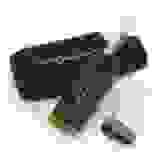
Although I much prefer all-in-one systems contained within the bottle, this is a popular device for backpackers all over the world, so I thought I’d discuss it here.
The important thing to remember is that the SteriPEN kills the microorganisms in the water with UV light, but does not actually remove them; it’ll be safe, but you’ll drink them right up. This also means it won’t remove chemicals, metals, particles, or anything else.
It’s possible to combine this with extremely cheap carbon filter bottles, which only remove large particles and certain chemicals, and thus combining them together would provide a more complete system. The Camelbak Groove and Brita water bottles come to mind.
You also need to use clear water, because the UV light will get blocked by sediment. You really don’t want to use this on muddy water, ever. You don’t want to use any filter with muddy water, but the other filters will actually clean it, which will damage the lifespan of the filter, but drinking muddy water with a SteriPEN might damage the lifespan of you.
The SteriPEN claims battery life long enough to clean 100 liters with 4 AA lithium batteries (about $2 each), which could be even cheaper with rechargeables (seriously, why does no one use rechargeable batteries?). The manufacturer will replace the bulb for $60, so the combined cost is still fairly cost-effective over long periods, but again, you’d need a separate filter if you wanted to remove metals, chemicals, and other stuff.
- Unit price: $100
- Replacement parts: $60 bulb, batteries of varying cost
- Lifespan: Approximately 8,000 liters (bulb lifespan)
- Initial water treatment cost (SteriPEN + 4 AA lithium batteries): $1.08 per liter
- Recurring water treatment cost (batteries + bulbs): $0.10 per liter
- Weight: 4 to 8 ounces with batteries, depending on the model (115 to 230 grams)
Buy it here.
8) The Sawyer Filter Bottle: $50
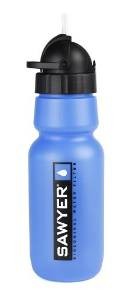
I have pointed out on many occasions that if you are only hiking in North America (and other places where viruses aren’t a problem), this is probably the best option out there.
The Sawyer bottle has a 0.1 micron filter size, which is good for everything biological except viruses, and it won’t handle chemicals, either, so it’s no good for low-quality tap water; but it’ll handle 99.99999% of bacteria, along with other bacterially-sized microorganisms (cysts, protozoa, etc), which works just fine for filling up from a river in the mountains, and is guaranteed to last for 3.7 million liters (minor note: these claims have been put to the test, and have been shown to come up short; it’s probably best to replace the filter long before the lifespan guarantee runs out).
There’s the arguable advantage of having something all-in-one, which can handle hiking and international travel and icky tap water, and some people might prefer that sort of minimalism; but if all you need is something for outdoorsy North American recreation, this is a good one.
- Unit price: $50 (though frequently found on sale)
- Replacement parts: None; buy the whole thing again
- Lifespan: 3.7 million liters (as mentioned, this claim is not sufficiently backed with evidence; it’s probably best to use it for a few months, just like the others)
- Initial water treatment cost: $0.000013/liter
- Recurring water treatment cost: $0.000013 per liter (as mentioned, it won’t last as long as they say, so this number should really be much higher)
- Weight: 5.5 ounces (155 grams)
Get it here.
There’s an in-line filter as well, for attaching to a hydration bladder, which offers the same performance.
Final thoughts
As you may have noticed, I’m a big fan of all-in-one designs. With the exception of specialized devices like the Sawyer Bottle and SteriPEN, all the options on this list can handle chemicals, bacteria and bacterially-sized things, and even those pesky little viruses (though with varying removal rates), though I would recommend using the ones with the highest removal rates if you’re going somewhere seriously questionable. Other pros and cons include some with great long-term cost-effectiveness, while others might offer swappable filters for low-grade filtration in less risky areas, and others might just fit better in your cup holder. A lot of this comes down to personal preference and ease of use, but performance is worth taking into consideration as well. But for reasons related to performance and ease of use, I’m sticking with the Grayl for now.

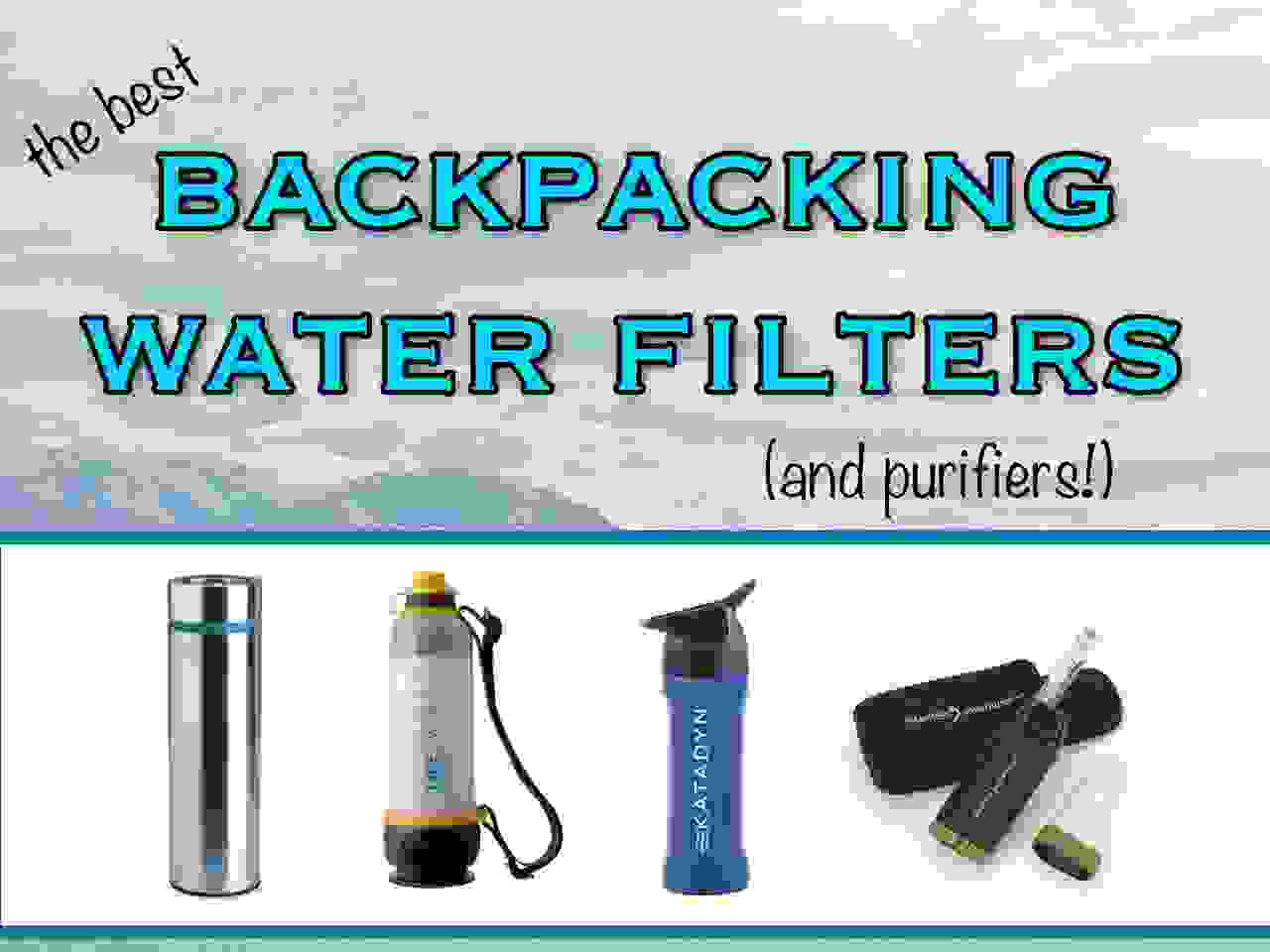



Great information! Thanks for taking the time to write it all up. And thanks for using proper grammar (specifically the correct usage of “its” and “it’s”). Random, I know… But I get so sick and tired of so many bloggers misusing “it’s” and “its” and “your” and “you’re.”
So, I see I’m a little late to the party BUT…I’m quitting my job and going on a 4-5 month cross country trip (with my dog) this summer-fall. Plan to spend at least one night in each of the lower 48 and will be predominately camping with a lot of hiking/backpacking. I need a drinking system for two reasons: (1) I prefer a more environmentally friendly (reusable) system and (2) I’d like the option of a purification/filtration system if it is needed for drinking from fresh water sources as well as sketchy gas station bathroom sinks. Seems like this post is better suited for more sophisticated world travelers but was hoping you could make a recommendation? Thanks!
Don’t worry, we’re not sophisticated. So: If you need purification, either you can use one of the bottles listed above that can handle viruses (Lifesaver, Katadyn, or GRAYL), or you can use a regular, non-purifying water filter bottle (the Sawyer is the best for that) and then supplement it with iodine tablets or UV lights. Any of those will work.
…except for the fact that you have a dog. If you want to pour water into a portable bowl for your dog, you have only two options: Lifesaver and GRAYL. The others require sucking through a straw, so you can’t pour water out for anyone else. I’d recommend watching a couple Youtube videos on how they operate to see which one you like best, since the mechanisms work quite differently. I think the GRAYL will probably be easier to use (particularly when pouring for others), but the Lifesaver will become more cost effective after several years of use.
Thanks for the info! Happy travels!
Hello
Thank you so much for your opinions and reviews. I am travelling to South America, Central America and Mexico over the next 12 months. I was wondering whether a water filter would be enough,something like the Sawyer bottle or whether it advisable to have a filter/purifier in one??
Thank you
I would be suspicious of tap water in Central and South America, and I’d want something that can kill viruses. It might not be necessary in Argentina, but I would expect in places like Nicaragua or Honduras that you’d want viral-level filtration. You can combine the Sawyer filter with a SteriPen, and that’ll take care of it, though I tend to prefer all-in-one bottles.
Take a look at the Water-to-Go bottle, very light to carry, 3 in 1 filter system developed by NASA, tested for just about anything you’d come across when travelling and loads cheaper!
Yeah, it looks like a good one, and uses a technology that sounds like it’s the same as the Grayl.
I like the lower price point and lighter weight of the Water-To-go, but think I’ll stick with the non-plastic container of the Grayl.
The water to go is s pile of ****
You can’t even squeeze the bottle it is so damn hard , what’s the point sucking like hell, going blue in the face for a thimble full of water and their test results do not stack up either
Just say it how it is but it only costs £13 to £25, and doesn’t work.
And you can’t make hot water for s coffee or a tea or some noodles or other with the water produced because it is in your mouth, because it’s the only way to get the water out, a thimble full anyway
Sorry Snarky , it is definitely not a good one!!
I agree with all of your points, along with the fact that its viral filtration capability isn’t as good as the others. My favorite right now is the Grayl (specifically the new Ultralight), which also allows you to pour water out for coffee or tea. But I did want to provide a few alternatives that at least had similar capabilities (even if they weren’t quite as good), in case some people out there prefer a straw option.
It was not developed by NASA
I think he meant the adsorption filter has some connection with NASA, not that they invented any particular product. I don’t know all the details, though.
Thanks so much for this good article. I’m not going anywhere. :) But I’d like to know which water filtration bottle you would recommend for just city use here in the USA? Preferrably a bottle that’s easy to use. All the bottles on Amazon confuse me, some being easier to use than others I suppose. But I’d just like the best clean water to drink. Money is not an issue. Thanks for any help you can give me.
That’s actually a good question, because it can potentially depend on the region, but for the most part, I think that for city use, you’re really only going to be concerned with chemicals, so I would expect just an ordinary carbon filter to do just fine. The Camelbak Groove is a good example (though I’m just offering it as an example, as I haven’t tried each and every potential option). Just keep in mind that it’ll handle chemical filtration, rather than biological. I like the idea of an all-in-one device (like some of those listed above), but specialized filtration, such as chemical-only or biological-only would be cheaper than all-in-one, and would make more sense if that’s all you have to do.
Wow, that was a quick reply! I’m curious…I like to add raw lemon juice to my water. Will these filters just filter it out? Will adding flavors hurt the system? Thanks.
It’s been a stay-at-home type of day. But anyway, I think it would depend on the filter, but the point of all these filters is to remove everything that isn’t water, so they should remove any added flavor, but I expect carbon filters would remove added flavor much better than membrane filters (the type that have tiny pores). The only one that could potentially work with flavors is the Grayl, since you could filter the water first, then you can add flavors through the top lid, which would bypass the filter. But I don’t know how this would affect the system. I expect it would simply be yet another particle that the filter would try to remove. On the other hand, you could just fill up the Grayl, pour it into another bottle, and then flavor it. That would work just fine.
Thanks so much for your good answers! I’ll take another look at that Grayl. Keep up the good work, this is an interesting subject! And have a great day!
If you’re looking for a good “at home” filter, I highly recommend this:
http://www.amazon.com/MAVEA-1001125-Elemaris-Filtration-Pitcher/dp/B002U50QQQ/
I’ve been using this for months now, and absolutely love it. I couldn’t attach a filter to my kitchen faucet, and didn’t want a Brita, because they’ve kind of sucked, in my experience. I didn’t want to deal with a complicated under-sink filter, either. So, I was really happy to come across this one. I even take it on car road trips and fill it with water wherever I’m staying. Think of it as a way-better Brita. Obviously, this kind of filter is to be used with water that is potable, coming out of a faucet here in the States. Best of luck.
I ordered a grayl and purifier filter from online. This article helped.
Happy to help. Some of these are lesser-known options, so I’m glad to get the word out.
Hello
What do you think about the Travel Tap from DrinkSafe Systems?
http://www.drinksafe-systems.co.uk/products.php
Claims that it provides filtered and purified water, and from what I can see is cheaper than the others on this page.
I’m thinking of getting one for my trip to central and south america later this year.
Thanks
Hmm…that one doesn’t specifically mention viruses. There’s one on the page that does (the Eco Bottle), and it looks like it’s priced similarly to these, although it also claims to last longer. I’m having trouble finding more info than just the claims from the company itself, but if their claims are accurate, it looks pretty good.
Hi, I am looking to possibly buy a filter bottle for my 13 year old nephew from Wisconsin to use on a camping trip in Mexico next summer…most of these are far out of our price range for a birthday gift…he won’t be using it a ton and it needs to be something a 14 year old can manage…What are your thoughts on this one…will it filter/purify what he needs (I am struggling to find the listing without reading a ton of user reviews):
http://www.amazon.com/Seychelle-Advanced-Filter-Purification-Filtration/dp/B004DZMD08/ref=sr_1_28?s=sporting-goods&ie=UTF8&qid=1401910599&sr=1-28&keywords=water+filter#
Thank you thank you!
Yeah, that’ll do just fine. For North American camping trips, you wouldn’t need viral-level filtration, and probably not chemical filtration either. The reason I highlight the ones above is because traveling to all sorts of different countries requires all sorts of different things, which is why I like the all-in-one designs, but for just camping, you don’t necessarily need the high-end options. Take a look at the Sawyer bottle as well, which is similar to this one.
Thanks! We are looking at the Sawyer one too!! Thanks again!
Thank you thank you!
Thanks for all the info – very helpful. I decided to get the Sawyer water bottle ($30) PLUS the SteriPen classic ($70) together.
I looked at how many liters of water I would get when considering the options/price (almost wish I went with the Lifesaver-but not in the store of course).
Any thoughts on how to maximize getting all the bad stuff out with this combo?
The cleaner it is to begin with, the longer the filter will last. Quickly running water (especially if it’s clear), whether it’s from a river or a faucet, will likely be a lot better.
great write-up. I just got the mini sawyer and was a bit disappointed that it wont filter chemicals. I think I will try the Grayle out, looks like it removes most everything and can be poured from to fill containers :)